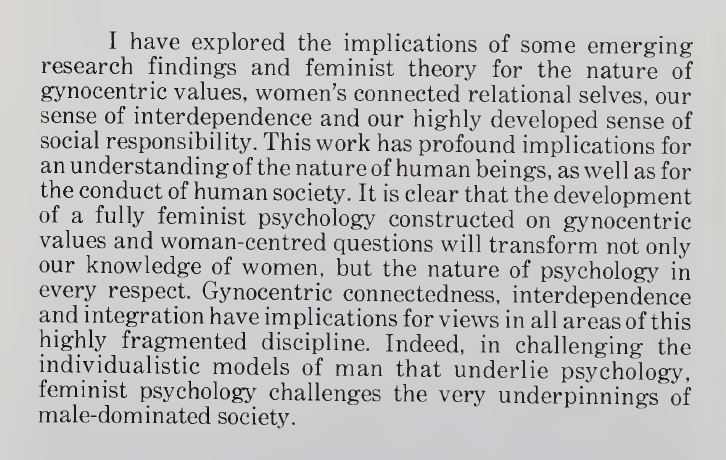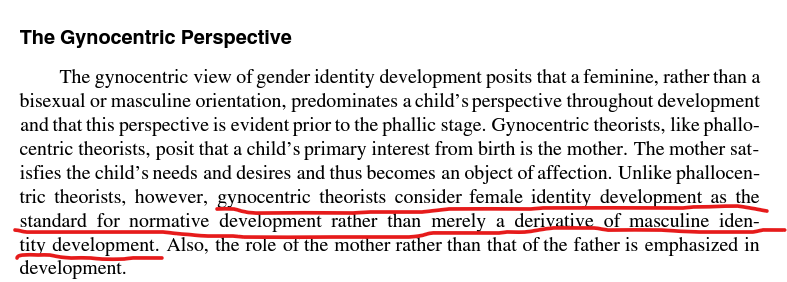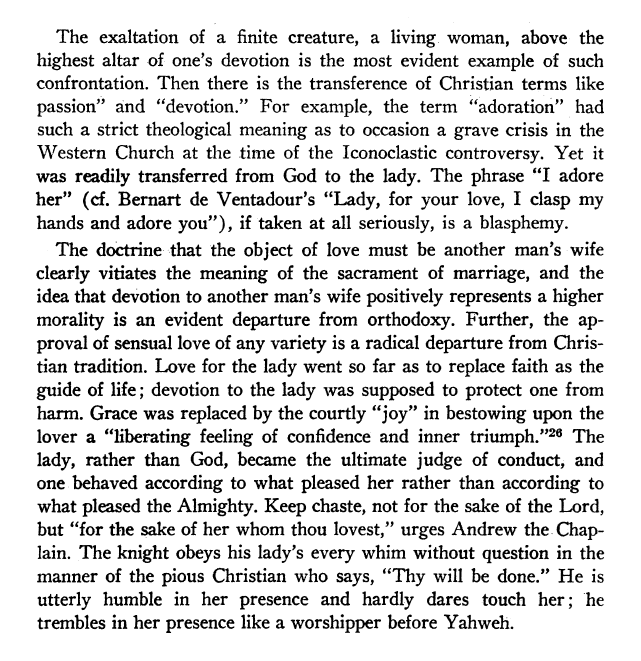Process philosophy assumes that the universe and human systems are ‘continually becoming.’ It emphasizes the elements of change and novelty as contrasted with a belief in permanence of forms, and uniformity. In the Greek tradition Heraclitus said that no person ever steps into the same river twice, because on the second attempt it is not the same river and he is not the same man.
Vaginoplasty, womb transplants, hormone blockers, hormone injections. These things represent the crowning achievement of cultural feminism, creating a kind of unforeseen gyno-dystopia resulting from the elevation of all things female. That same feminism exerts a gravitational pull that tends to filter all human events through its interpretive lens. Many women show their participation in the feminist worldview via postures of gendered narcissism, while men might show their participation in it by acts of chivalry or, more recently, by initiating changes to their sexual and gender orientation (MtF) in order to become more like women.
Gynocentric feminism is the soil from which the transgender revolution has sprouted – a revolution that represents nothing less than a dissolution of centuries of accumulated gender customs. As Simone de Beauvoir (1949) famously stated of the feminist position, “One is not born, but rather becomes, a woman. No biological, psychological, or economic fate determines the figure that the human female presents in society; it is civilization as a whole that produces this creature.”
The feminist perspective paved the way for gender to be delinked from sex, which appears to have opened the floodgates for men to adopt the celebrated gender identity of woman. Before we draw some ultimate conclusions about this development, lets first look at how female gender identity came to be celebrated.
The historical rise of gynocentrism
Putting the teenage trend of FtM transitioning to one side, we can conclude that mature age MtF transitions in the European and Anglosphere contents predominate, especially in the USA which has for centuries been a champion of more extreme forms of gynocentrism, as demonstrated by the following prima facie observations:
In 1846 a London Sun article describes American culture as an epicenter of exaggerated gynocentrism & chivalry:
I am convinced that a lady, no matter what her age and attractions might be, could journey through the whole extent of the union, not only without experiencing a single annoyance, but aided in every possible way with unobtrusive civility. Indeed a great number of Saphonisbas and Almiras do travel about, protected only by the chivalry of their countrymen and their own undoubted propriety.
To them the best seats, the best of everything, are always allotted. A friend of mine told me of a little affair at New York Theatre, the other night, illustrative of my assertion. A stiff-necked Englishman had engaged a front place, and of course the best corner: when the curtain rose, he was duly seated, opera-glass in hand, to enjoy the performance. A lady and a gentleman came into the box shortly afterwards; the cavalier in escort, seeing that the place where our friend sat was the best, calling his attention, saying “The lady, sir,” and motioned that the corner should be vacated. The possessor, partly because he disliked the imperative mood, and partly because it bored him to be disturbed, refused. Some words ensued, which attracted the attention of the sovereign people in the pit, who magisterially enquired what was the matter?
The American came to the front of the box and said, “There is an Englishman here who will not give up his place to a lady.” Immediately their majesties swarmed up by dozens over the barriers, seized the offender, very gently though, and carried him to the entrance; he kicked, cursed, and fought all in vain: he excited neither the pity nor the anger of his stern executioners; they placed him carefully on his feet again at the steps, one man handing him his hat, another his opera glass, and a third the price he had paid for his ticket of admission, then quickly shut the door upon him, and returned to their places. The shade of the departed Judge Lynch must have rejoiced at such an angelic administration of his law! – England in the New World.
In 1856, author of Putnam’s Monthly Magazine published the following summary of the relations between men and women in America:
“Long before the cry of woman’s rights was openly raised, the powers and prerogatives of the American husband had been gradually undermined. Usage superseded law, and trampled it under foot. Sentiment put logical consistency at defiance, and the American husband has thus become a legal monster, a logical impossibility, required to fly without wings, and to run without feet.
“While the wife is thus rendered to a great extent independent of her husband, he, by a strange inconsistency is still held, both by law and public opinion, just as responsible for her as before. The old and reasonable maxim that ‘he who dances must pay the piper,’ does not apply to wives—they dance, and the husband pays. To such an extent is this carried, that if the wife beats her husband, and he, having no authority to punish her in kind, applies to the criminal courts for redress, she will be fined for assault and battery, which fine he must pay, even thought she has plenty of money of her own. or, in default of paying, go to jail! Such cases are by no means of unprecedented occurrence in our criminal courts.
In 1903 culture critic Max O’Rell observed the following about gynocentrism in the USA:
“The government of the American people is not a Republic, it is not a monarchy: it is a gynarchy, a government by the women for the women, a sort of occult power behind the scenes that rules the country.”
Price Collier observed in 1909:
In England the establishment is, as a rule, at any rate from a man’s point of view, more comfortable than the American home. Americans staying any time in England, whether men or women, are impressed by the fact that it is the country of men. Likewise the English, both men and women, who visit America are impressed by the fact that America is the country of women.
The Independent reported the following in 1909:
“In Europe the aristocracy is largely relieved from drudgery in order that they may cultivate the graces of life. In America the attempt is being made to relieve the women of all classes from drudgery, and we are glad to see that some of them at least are making good use of the leisure thus afforded them. It is a project involving unprecedented daring and self-sacrifice on the part of American men, this making an aristocracy of half the race. That it is possible yet remains to be proved. Whether it is desirable depends upon whether this new feminine aristocracy avoids the faults of the aristocracy of the Old World, such as frivolousness and snobbishness.”
Irishman George A. Birmingham wrote in 1914:
“There are people in the world who believe that we are born again and again, rising or sinking in the scale of living things at each successive incarnation according as we behave ourselves well or badly in our present state. If this creed were true, I should try very hard to be good, because I should want, next time I am born, to be an American woman. She seems to me to have a better kind of life than the women of any other nation, or, indeed, than anybody else, man or woman… American social life seems to me — the word is one to apologize for — gynocentric. It is arranged with a view to the convenience and delight of women. Men come in where and how they can…. The American woman is certainly more her own mistress than the Englishwoman, just because America does its best for women and only its second-best for men. The tendency among American humourists is to dwell a little on the greed of the Englishman, who is represented as incapable of earning money for himself. The English jester lays more stress on the American woman’s desire to be called “my lady,” and pokes sly fun at the true Democrat’s fondness for titles. The American man is reverent toward women. It is not the homage of the strong toward the weak, but the obeisance of the inferior in the presence of a superior. This difference of spirit underlies the whole relationship of men to women in England and America. The English feminist is up against chivalry and wants equality. The American woman, though she may claim rights, has no inducement to destroy reverence.
Albert Einstein observed in 1921:
Above all things are the women who as a literal fact, dominate the entire life in America. The men take an interest in absolutely nothing at all. They work and work, the like of which I have never seen anywhere yet. For the rest they are the toy dogs of the women, who spend the money in the most unmeasurable, illimitable way and wrap themselves in a fog of extravagance. They do everything which is in the vogue, and now quite by chance they have thrown themselves on the Einstein fashion.
Summary and conclusion
Based on the above collection of artifacts, we can begin to wrap these details into a coherent conclusion, and for this we’ll turn to Georg Wilhelm Friedrich Hegel (1770–1831) for a template.
Hegel naturally didn’t write about vaginoplasties or the transgender movement, but he did write about process philosophy and the proposition that social processes are an ever-recurring cycle which he characterized by three phases (1) an initial set of cultural beliefs called a thesis, (2) next arises dissatisfaction and a negation of that thesis called the antithesis, and lastly (3) there occurs a synthesis of culture beliefs whereby the two conflicting ideas are reconciled to form a new proposition.
Thesis – Antithesis – Synthesis.
This provides a suitable template for organizing the peculiar shifts in gender ideology we’ve been witnessing over recent centuries which, following Hegel, we can now organize as follows:
-
- Thesis: Centuries of gynocentrism
- Antithesis: Men’s rights backlash
- Synthesis: Discovery of malleability of the sexual body (hormones/surgery), accompanied by belief in gender fluidity, resulting in a dissolution of clear sexual and gender boundaries, along with all traditional culture privileges that have accumulated around biological sex. [This completes the synthesis of the two conflicting ideas]
As mentioned elsewhere, the transgender movement is not a cause célèbre driven by men’s rights advocates, as is sometimes claimed. Rather, the current support for transgender rights is derived from the power of government administrations and global regimes playing “freedom one-upmanship” – ie., the feigning of moral purity to position themselves at top of the global hierarchy.
The elites however are not the ones ultimately driving this process forward, even if they are doing the job of hastening, supporting and exploiting it. Instead, it appears to be Hegel’s mysterious process philosophy that is driving the changes, and the elites and sundry grifters are riding this gender-bender horse in a rodeo of competing cultural powers.
Where does all this leave us?
We can draw the conclusion that over the last century our framing of gendered customs has become increasingly captured by a gynocentric turf war between traditional women, and progressive feminist forces, with trans activism being an emerging force that is actively working to disrupt it. Time will tell if the transgender movement continues its disintegrative influence over traditional sex roles, however the surgical and chemical technology that has allowed this to flourish does not look like disappearing anytime soon – in fact researchers are just getting started.
The chemical invention of the birth control pill for women, introduced in the 1950s, served to crown the gynocentric culture project and to cement the dominance of its centuries-long evolution. The chemical and surgical “support” for trans-people holds equally gargantuan potential; which includes the tangential possibility of leading us past the polarizing gynocentric setup of recent centuries and back to a saner place – post trans hysteria – where everyday men and women can be themselves without coercion and judgement… notably minus those inflated gender privileges and ideologies that have driven us into this absurd position to begin with.
See also:
Image by Freepik



